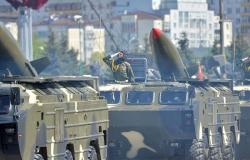Hezbollahthe Lebanese Shiite movement responsible for the AMIA attack, is one of the most serious threats facing Israel today.
With the financial and military support of Iran, it represents a latent danger from the southern border of Lebanon, in the north of Israel. There, according to the site Zman Yisrael, “It has built a vast network of tunnels much more sophisticated than that of Hamas” in the Gaza Strip.
Read also: Israeli army intelligence chief resigns after admitting mistakes during brutal Hamas attack
“We don’t know exactly what weapons he has in his arsenal. But it does seem that he still has high-caliber weapons that he has not used so far in his confrontation with Israel. “Hezbollah remains a serious military threat to Israel,” he summarized to TN the analyst David WoodLebanon specialist for the Crisis Group, an NGO dedicated to the prevention of armed conflicts.
Hezbollah’s firepower on the border with Israel
Israel has several open fronts in its war with Hamas. Since the beginning of the conflict it has been attacked by Iranian “proxy groups” from the Gaza Strip, Lebanon, Syria, Iraq and Yemen, as well as by Tehran directly.
But it is on its northern border where tension remains at the highest level. There, from southern Lebanon, Hezbollah is perhaps the best armed and nourished Iranian proxy group in the Middle East.
Members of the Lebanese Shiite movement Hezbollah (Reuters)
By: REUTERS
The leader of the group, Hassan Nasrallah, claims to have 100,000 combatants. A recent report by experts cited by German TV Deutsche Welle maintains that the terrorist group would have around 130,000 rockets (without autonomous guidance system) and numerous missiles of Iranian, Chinese and Russian manufacture.
It is no coincidence that the group launches missiles almost daily against the north of Israeli territory. Since the start of the war, tens of thousands of people have fled their homes in towns near the Israel-Lebanon border.
Read also: Saudi Arabia takes advantage of the crisis in the Middle East: it helps Israel and draws closer to the United States
“Hezbollah is a powerful Shiite militia-party that has strong influence in Lebanon. Maintains a massive arsenal of weapons outside the control of the Lebanese state and also operates as a political party with ministers and parliamentarians,” Wood commented.
Hezbollah tunnels on the border with Israel
But Hezbollah does not only feed on weapons. According to Zman Yisrael, its tunnel system in southern Lebanon runs hundreds of kilometers to the border. Even, it is suspected, they would reach Israel.
Tal Beeridirector of the Alma Center’s Research Department and former member of intelligence units of the Israel Defense Forces, is convinced that the militants can fire precision-guided missiles from there and then disappear without a trace.
The probable route of a 45 km Hezbollah tunnel in southern Lebanon (Graphic: Alma Research and Education Center)
Hezbollah’s tunnels have been the subject of study by the Alma Research and Education Center, which focuses on security challenges on Israel’s northern border.
According to their research, these underground passageways began to be built long before those in Gaza. “Existing intelligence indicates a vast network of tunnels in southern Lebanon, deep and multi-pronged,” he wrote. The Israel Times.
Read also: From a clerical republic to a military one: Iran’s internal changes that translate into the conflict with Israel
According to Beeri, these tunnels are spread across 36 geographic regions, cities and towns of southern Lebanon with enormous influence of Hezbollah. Some are even interconnected with each other. In total they would cover hundreds of kilometers.
The expert even mentioned that his research obtained images of trucks inside tunnels with several connected branches.
The different types of Hezbollah tunnels
According to Beeri, there are different types of tunnels in Lebanon. Some are from “stroke”, large and extensive. Vehicles and medium trucks enter there. There are also those called “tactical” intended for the movement of militiamen and perhaps the passage of motorcycles. They would serve to launch attacks and quickly regroup to resupply internal warehouses. Finally, there are the so-called “next” that reach the border with Israel.
These tunnels began to be excavated in the 1980s with advice from North Korea, according to Beeri. In recent years, Iran’s help was essential to expand the network.
According to the investigation, the last tunnels were in charge of a company called Jihad Construction under the protection of agricultural projects and reconstruction of buildings of the Shiite community in the Baalbek region.






